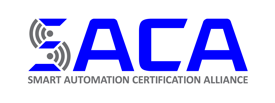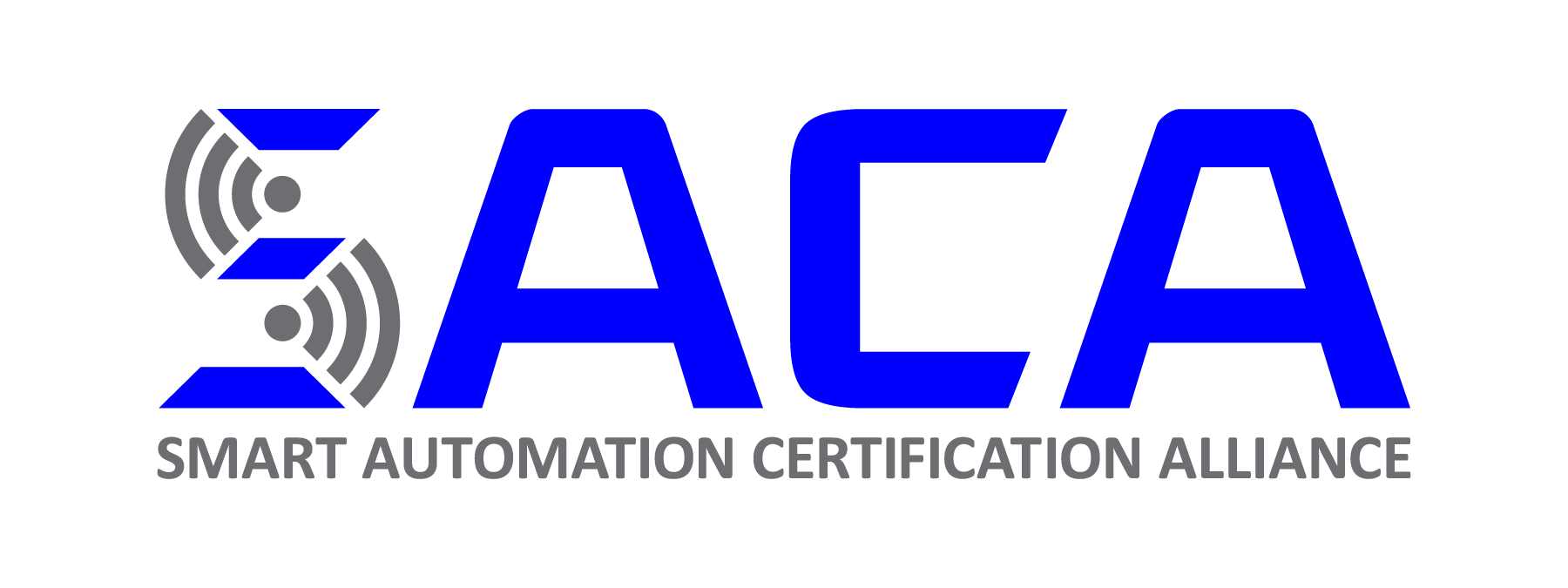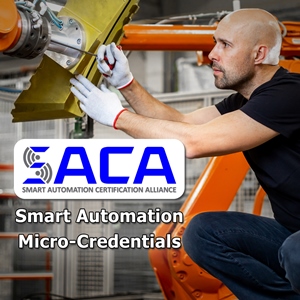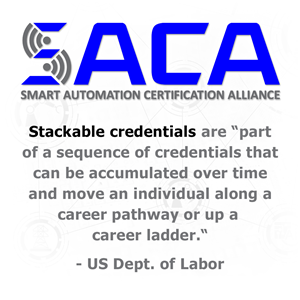Instructor Profile: Maroun Nehme
Maroun Nehme, director of Buena Park High School’s Advanced Robotics and Mechatronics program, started folding SACA into his program shortly after he became the head of it. He said it started off as a way to get something in the hands of students along with their diplomas, but it’s turned into a lot more.
He got his Gold SACA instructor certification and began testing his students for the Gold credentials. After seven students passed the Silver exam, six attempted and passed the Gold exam.
“We became the very first college or high school in California to have Gold Certified students and a Gold Certified instructor,” Nehme said.
He said he wanted to make sure his students got a little recognition, so he began posting their projects and accomplishments on social media.
That’s when his community began taking notice. A councilman for the Buena Park City Council saw the hands-on training in action, and asked Nehme to bring his students to a public meeting to honor them and their work. He also said industry began taking notice and wanted to see how they could benefit from Nehme and his lab.
“Their parents were super stoked and I think it just gives more recognition to the program,” Nehme said. “And now we’re beginning to partner up with some companies that may use my classroom as a training facility for their employees, which is pretty big for a high school.”
He said it was a big deal, especially since he wasn’t sure how to deliver SACA curriculum at first. Nehme said a presentation from Joe Russo at Klein Educational Systems helped him see how to keep things moving. Working with students in pods helped him make sure he could keep 30 students going at once and still give them time to test on the necessary skills.
Watching them gain interest in the first year is huge, he said, and part of that is how the initial curriculum is built.
“I like the 101 curriculum because it gives students a taste of everything,” Nehme said. “It doesn’t go super deep into anything, but it gives them a taste of all these different things, whether it’s electrical, pneumatics or robotics. They go into year two, they’re doing the same thing and they can decide what they want to learn, what they want to pursue.”
He said that gives them opportunity once they graduate outside of just going to a four-year institution. He said it helps motivate students while they’re in high school, and find paths to high-paying careers once they graduate.
“I think one of the roles that SACA fills is provide for not just the students, but their parents, a purpose for them to go to school,” Nehme said. “They would like them to get into some kind of career where they can learn a trade and earn a decent living, especially in Southern California. If a student wants to go into a field, they can stack those certifications and use them to get a job.”
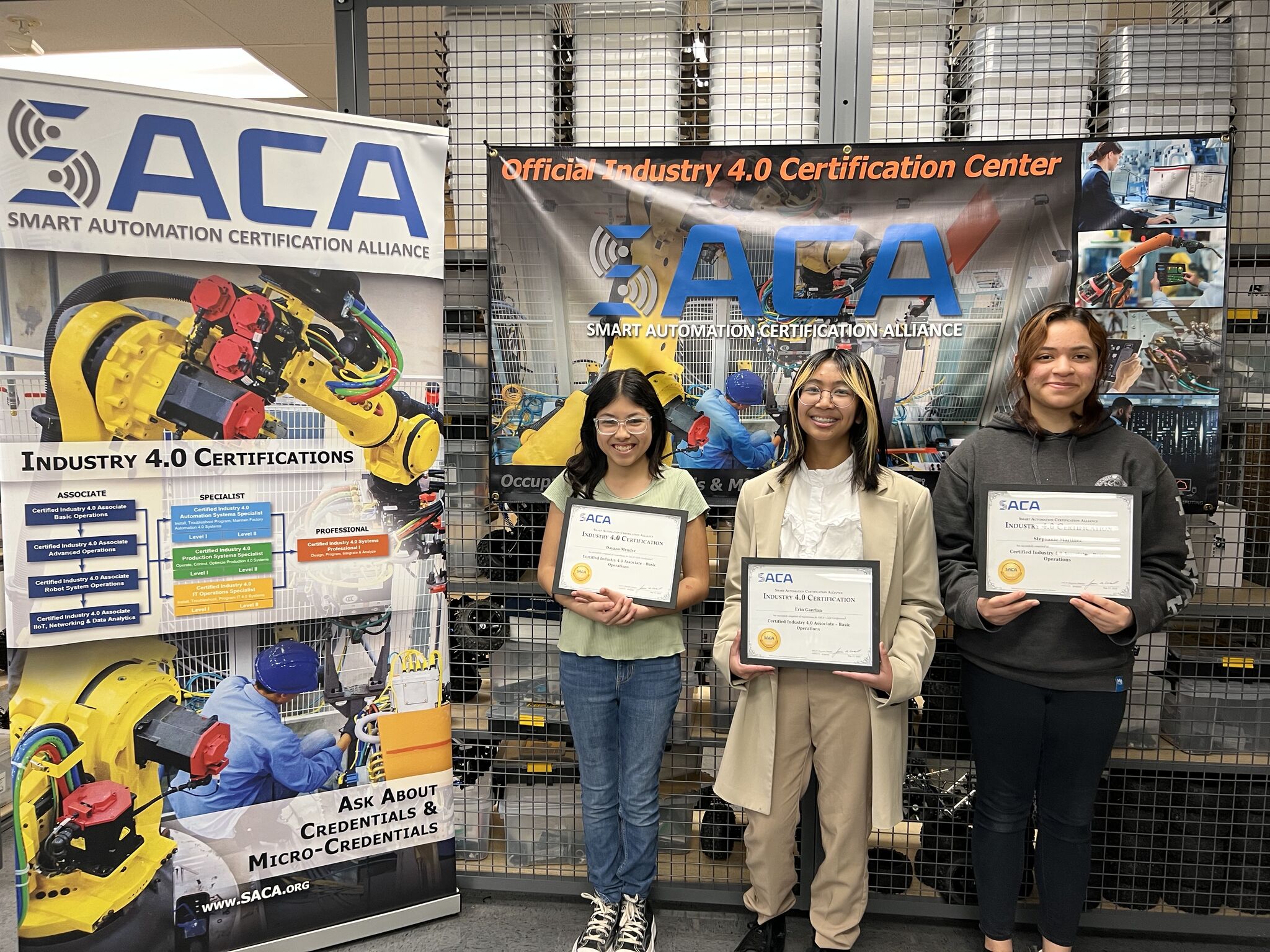
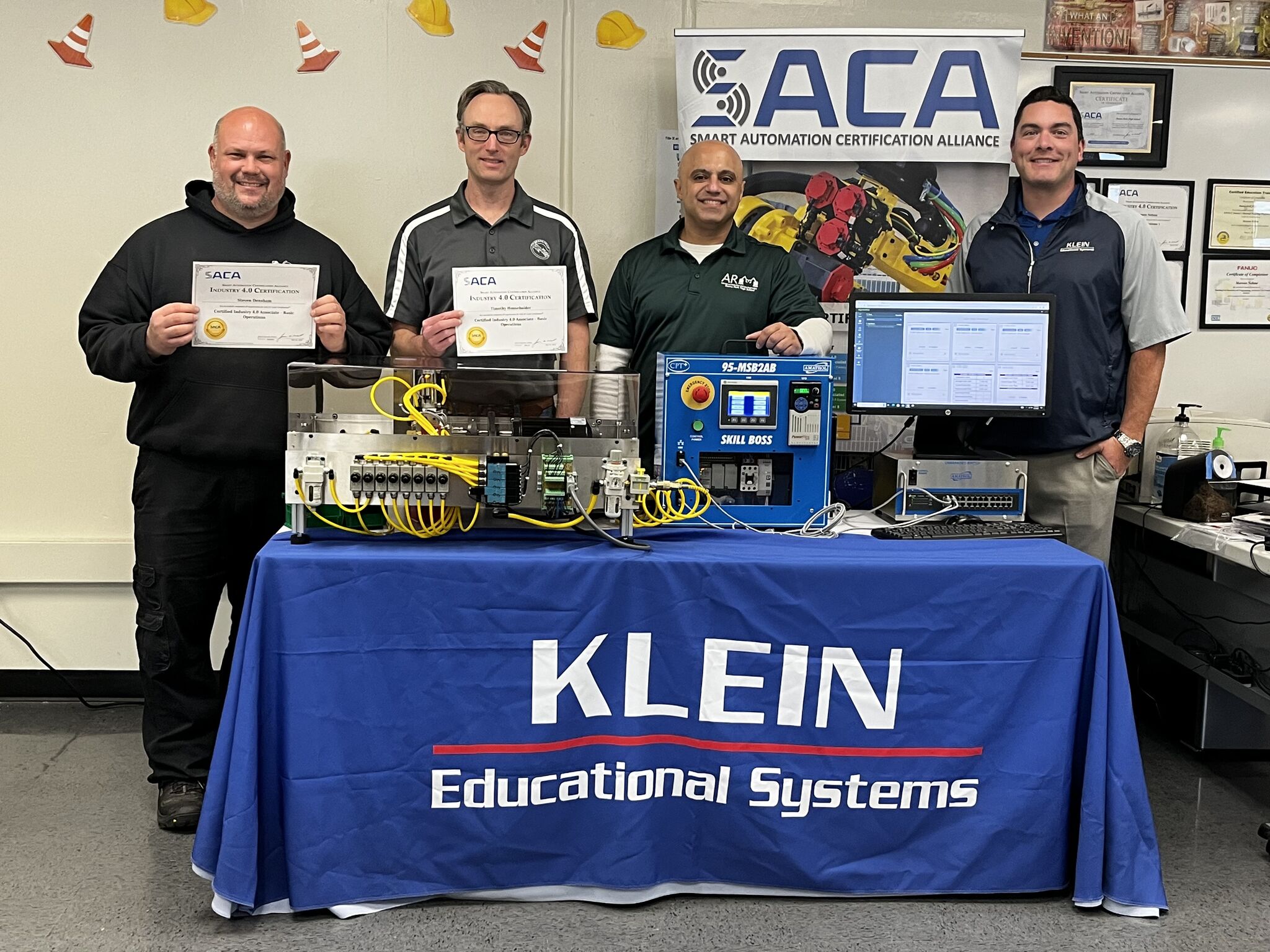
- Published in News, Technology
New SACA Credentials
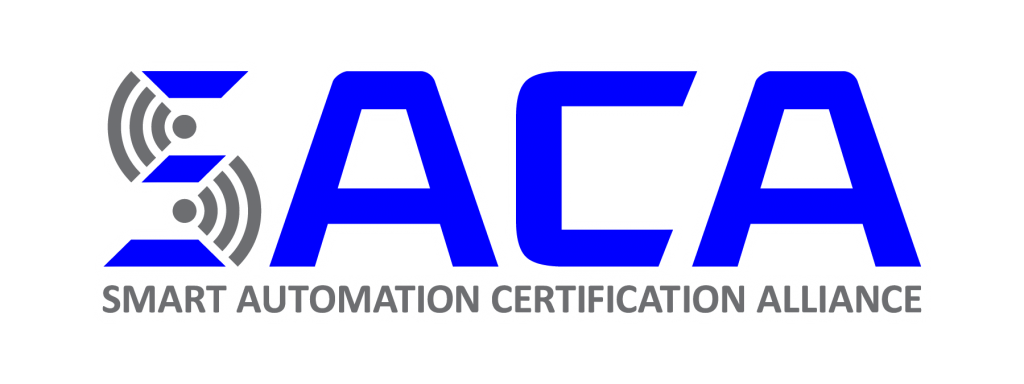
The Smart Automation Certification Alliance (SACA) is offering our members the opportunity to be among the first organizations in the world to pilot six new industry-aligned micro-credentials. These new micro-credentials expand SACA’s robust list of industry-relevant credentials and represent an exciting opportunity for your students or employees to validate their skills for careers in smart manufacturing.
These new micro-credentials are part of SACA’s Specialist Certifications. Each credential assesses competencies for individual technical topics like laser alignment and hydraulic maintenance, or they can be combined with other micro-credentials to form comprehensive occupational credentials such as Automation Systems Specialist, Mechanical Systems Specialist, and Electro-Fluid Power Systems Specialist.
The new SACA micro-credentials are:
- Hydraulic Systems 1 (C-255): To gain this credential, candidates will demonstrate knowledge and skills to: operate industrial hydraulic systems, apply hydraulic system safety procedures; monitor hydraulic system operation; connect and operate basic hydraulic components; check and charge accumulator pressure; monitor performance of hydraulic system pressure and force; and more.
- Hydraulic Maintenance (C-256): To gain this credential, candidates will demonstrate knowledge and skills to: maintain hydraulic systems at peak reliability, install O-rings in hydraulic components; connect and disconnect hydraulic hoses, hydraulic steel tubing, and fittings; maintain hydraulic filters; analyze and service hydraulic reservoir fluid; and more.
- Mechanical Power Systems 2 (C-301): To gain this credential, candidates will demonstrate knowledge and skills to: apply mechanical troubleshooting safety procedures; install and adjust timing belt drive systems, heavy-duty shaft coupling systems, heavy-duty chain drive systems, and heavy-duty V-belt drive systems; troubleshoot mechanical power transmission system; and more.
- Laser Shaft Alignment 1 (C-302): To gain this credential, candidates will demonstrate knowledge and skills to: apply laser shaft alignment safety procedures; perform a rough shaft alignment using a jack bolt system; use a laser shaft alignment system to check/correct for soft foot; analyze the shaft alignment; and more.
- Electrical Motor Troubleshooting 1 (C-303): To gain this credential, candidates will demonstrate knowledge and skills to: apply electric motor safety procedures; connect and test DC and AC motors, single phase and three-phase; measure electric motor performance; troubleshoot and diagnose electric motor faults and component failures in various motors; and more.
- Pneumatic Troubleshooting 1 (C-304): To gain this credential, candidates will demonstrate knowledge and skills to: apply pneumatic troubleshooting safety procedures; troubleshoot air preparation components, pneumatic actuators and valves, and vacuums lift components; troubleshoot pneumatic machine sequence and performance; and more.
These certifications are now on the SACA Portal Site for SACA members only. As a SACA member, your staff and students are eligible to take the assessments for these credentials while they are in pilot phase and there is zero cost to your organization or students!
The results from these pilot tests will be used to set the cut scores. All individuals who have taken the assessments will be notified of their results, either pass or fail. For those who pass, they will receive SACA Silver Certificates and become eligible to be assessed for Gold level.
If you’re interested in piloting these new certifications, please log in to the SACA Portal site. If you’re an administrator or instructor, you will be able to assign these micro-credentials. Once assigned to students and employees, you will need to proctor the test for those individuals. Admins and instructors can proctor their own micro-credential assessments while they are in pilot phase..
To prepare for the assessments or compare your current course content to the content in these assessment, please refer to the SACA standards on the Portal Site.
If you’re not currently a SACA member, but you’re interested in joining the Alliance, you can fill out member order forms here for Education and Industry.
- Published in News
Rockwell Automation Joins SACA as a Platinum Member, Director Praises SACA’s Efforts
Michael Cook, Rockwell Automation’s Director Global Academic Partnerships, recently endorsed the Smart Automation Certification Alliance’s efforts to create standards to ensure industry that potential employees possess up-to-date Industry 4.0 skillsets.
Rockwell Automation has also joined SACA as a Platinum Member, which allows them to offer SACA certifications to their employees and provide scholarships to sponsor educational institutions and teachers when they start new certification programs in Industry 4.0. This commitment will impact the standards and future direction of the certifications, and promote the leadership in Industry 4.0 education.
“Technology disruption is widening the gap between student learning and industry relevance of learning. At the same time, it is also shortening the shelf life of degrees and opening up variable pathways of learning. To narrow this gap we are actively participating with the Smart Automation Certification Alliance and other industry stakeholders working alongside education to create relevant standards around Industry 4.0 and more importantly access to relevant stackable learning.”
Michael Cook
Director Global Academic Partnerships
Rockwell Automation
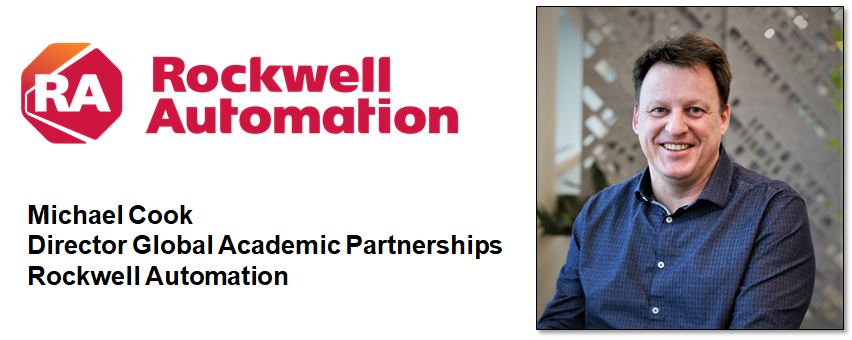
- Published in News
SACA Smart Automation Micro-Credentials | Fast Track to a Rewarding Career
Are you a technical education instructor that keeps hearing from your students that they need to get a job before they finish their degree? Do they possess a proficiency in areas like basic electrical skills, mechanical drives, industrial networks, robot operation, and more that could land them a job while they work on their degree, and they just need documented verification of their proficiency? You should look into the Smart Automation Certification Alliance’s micro-credentials!
SACA’s micro-credentials are hyper-focused, competency-based certificates that verify proof of knowledge and skills. Micro-credentials offer a streamlined way to document what your students know so that they can contribute to the local industrial workforce right away. Basically, micro-credentials do not measure how long you study or how many courses you take; they measure your understanding of a topic and your ability to demonstrate your skill-based competency of the subject.
If micro-credentials interest you, the Smart Automation Certification Alliance (SACA) is your answer to prove that your students possess the necessary skills to be successful in an Industry 4.0 manufacturing environment. SACA micro-credentials verify that an individual possesses basic industrial skills such as electrical, mechanical, fluid power, rigging, and welding all the way through advanced robot system integration, Industry 4.0 data analytics, and network security. Eventually, these micro-credentials stack into an industrial certification that demonstrates your skills and knowledge to current and future employers across multiple industrial disciplines.
- Published in News
SACA Receives SRE Designation from the Department of Labor
On September 23rd, 2020, the Smart Automation Certification Alliance (SACA) was one of 18 initial organizations designated as a Standards Recognition Entity (SRE) by the United States Department of Labor. This designation allows SACA to “evaluate and recognize high-quality IRAPs (Industry-Recognized Apprenticeship Programs) consistent with the Department’s standards.” IRAPs are vital for industry as they are eligible for workforce development funds, so the training cost to the company can be offset.
This designation also allows SACA to work with companies and/or schools and non-profits that work with companies to create and build IRAPs that are aligned to both local industry needs and industry-recognized credentials.
What is an SRE?
Apprenticeship.gov states that a Standards Recognition Entity (SRE) is a third-party organization such as a trade group, company, educational institution, government agency, nonprofit organization, union, etc. that is designated by the United States Department of Labor to recognize apprenticeship programs as IRAPs. SREs were created to, “expand apprenticeship opportunities in industries where apprenticeships have been underutilized.” As examples of what SREs are responsible for, SREs will recognize or reject IRAPs, provide IRAP program and performance data to the Office of Apprenticeship, and establish policies and procedures for recognizing and validating compliance of IRAPs.
Industry-Recognized Apprenticeship Programs (IRAPs) are high-quality apprenticeships programs that have been approved by Department of Labor Standards Recognition Entities (SRE) and delivered by, “trade and industry groups, corporations, non-profit organizations, educational institutions, unions, and joint labor-management organizations.” The purpose of IRAPs is to provide individuals with paid work and training – complete with an industry-recognized credential – within industries where a skills gap is present in order to strengthen both the workforce and industry. High-quality IRAPs must meet requirements such as: providing paid work, having a written training plan, providing a safe work environment, being an Equal Employment Opportunity position, giving credit for prior knowledge, providing mentorship, and linking the program to industry-recognized credentials, to name a few.
- Published in News
Micro-Credentials: The Proof of Knowledge Solution for Industry 4.0
Everyone has taken courses from YouTube University. They encounter car repairs, home projects, or coding errors that they’re unable to fix with their current bank of knowledge, so they search YouTube for videos with intricate explanations and tutorials in order to learn solutions. This act is an informal version of what is referred to as “upskilling” – learning new skills in order to fill a personal knowledge gap in order to accomplish new tasks.
On the other hand, the world is full of people that are well versed in areas that aren’t their profession. Maybe you know an accountant that can repair anything on their car or a math teacher that can install a new electrical outlet in a house.
One thing that these two groups share: no one is going to find them when Google searching “mechanics near me” or “nearby electricians.” When people need a mechanic or an electrician, they want someone with credentials.
Attaining credentials usually involves multi-year degree programs or apprenticeships, which are great for people with no background in a subject. But what’s out there for people that already possess most of the knowledge and skills being taught in those programs? It’s a waste of time and money to send them back to square one because, “that’s how the program works.” And with technological development and adoption speeding up, areas like manufacturing and industry needs something that moves with the speed of change. Enter Micro-Credentials.
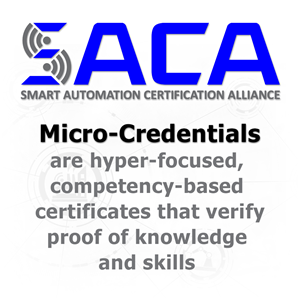
What are Micro-Credentials?
Micro-credentials are hyper-focused, competency-based certificates that verify proof of knowledge and skills. These certificates are meant to supplement degrees and advanced training, not replace them. Basically, micro-credentials do not measure how long you study or how many courses you take; they measure your understanding of a topic and your ability to demonstrate your skill-based competency of the subject. Micro-credentials are also modular, so people can use them to focus on improving skill weaknesses and prove their competency without having to rehash areas that they already know.
What are Stackable Micro-Credentials?
Speaking of modularity, another feature of micro-credentials is that they’re stackable, which is perfect for people in many scenarios. So what’s a stackable credential? As defined by the U.S. Department of Labor, stackable credentials are “part of a sequence of credentials that can be accumulated over time and move an individual along a career pathway or up a career ladder.” So for someone looking to move up the ladder, they can immediately attain credentials for areas where they are already proficient and then continue to add on new credentials as they learn new skills, which will show management a documented interest in continuing education and a commitment to professional growth.
These stackable credentials are also helpful for someone looking to find a new job in the field. They might have years of experience but nothing to verify to a new employer that they are indeed skilled in different areas and disciples. Micro-credentials offer a streamlined way to document someone’s skills without having to start over in a multi-year degree program. Micro-credentials give you immediate credit for things that you already know how to do!
In a third scenario, someone might be downsized from a fading industry and want a fresh start in a new business sector. Micro-credentials provide bite-size documentation of proficiency as this individual builds new skills. If this person wants to enter the manufacturing industry, they could take a handful of foundational courses at a local community college in areas like basic mechanical, basic fluid power, and basic electrical, and then earn corresponding micro-credentials, which would probably be enough to gain an entry-level position. Then the person can continue earning more advanced micro-credentials while they work and learn new skills or take more classes. Eventually, these micro-credentials would stack into an industrial certification that would demonstrate the person’s skill and knowledge to current and future employers across multiple industrial disciplines.
Why are Micro-Credentials Becoming Popular in Manufacturing?
As stated, micro-credentials are important for providing proof of knowledge among any workforce but they are vitally important within the world of manufacturing at the moment because manufacturing is undergoing a new industrial revolution, commonly referred to as Industry 4.0, the Industrial Internet of Things, or Smart Factory. Industry 4.0 takes traditional industrial applications and connects them using wireless internet to produce constant feedback on a variety of metrics including process efficiency, equipment downtime, predictive maintenance tasks, and more!
Employees with years of experience in manufacturing understand the basic technologies, but Industry 4.0 is introducing new technologies and applications that are beyond their scope of knowledge. It doesn’t make sense to start this group over in a bloated training program that begins with basic electrical, mechanical, or fluid power skills. Nor will it make sense for a business to stand still with a workforce that’s not keeping up with new technology as it’s adopted. This is where micro-credentials and SACA can help.
SACA: Certifying the Workforce for Industry 4.0

The Smart Automation Certification Alliance (SACA) is the answer for both education and industry to prove that the manufacturing workforce possesses the necessary skills to be successful in an Industry 4.0 environment. SACA certifications are industry-driven, developed through a rigorous process that begins with truly international skill standards and is endorsed by leading experts in Industry 4.0 technologies throughout the world. SACA’s Smart Automation certifications use a modular structure – including micro-credentials – to enable them to fit a wide range of individual needs, industries, and educational environments. SACA micro-credentials verify that an individual possesses basic industrial skills such as electrical, mechanical, fluid power, rigging, and welding all the way through advanced robot system integration, Industry 4.0 data analytics, and network security.
The world of manufacturing is changing. Gone are the days of dirty, dingy factories. The new shop floor is full of robots, smart components, wireless networks, and Big Data. SACA is the answer to ensuring that the workforce of tomorrow understands these new advances – as well as the basics of industry – and can demonstrate their competency in real-world industrial environments.
- Published in News
Indiana Governor’s New Initiative Offers Free SACA Silver Certifications for Hoosiers
During Indiana Governor Eric Holcomb’s June 5, 2020 press conference, a new state initiative was announced that will offer 10,000 free credentials to Indiana residents that have been dislocated from their jobs due to the COVID-19 pandemic. The Smart Automation Certification Alliance (SACA) is one of the organizations offering credentials to displaced Hoosier at no cost. SACA’s certifications are task-based and nationally recognized in preparing individuals for rewarding careers working with advanced manufacturing and Industry 4.0 technologies.It’s no secret the immense role that Industry 4.0 is expected to play in the future of industrial manufacturing.
These courses can be taken online and feature virtual simulation of industrial applications, which make them ideal for preparing users for the workplace. The online delivery also allows users to practice social distancing guidelines to help prevent the spread of Coronavirus.
Ivy Tech will coordinate enrollment of new students while Amatrol and Aidex will help to promote this opportunity to displaced Indiana residents seeking a new career path. Amatrol will also provide free access to its Learning Management System (LMS) for students enrolled in this program.
When a student completes one of the six courses, they will be eligible to sit for the associated SACA Silver Credential. SACA Silver Credentials are completed solely online while Gold Credentials involve hands-on skill demonstrations. Students are eligible to earn all six SACA Silver credentials.
People interested in these opportunities can visit YourNextStepIN.org, which is part of Indiana’s Rapid Recovery for a Better Future initiative. Lubbers said, ““Visitors to the site can talk to a real person to answer questions and help them determine the right path forward and the training options that will help them achieve their goals. These partners and tools help to connect Hoosiers to opportunities — some that already exist — and we will continue to build on these connectors in the weeks and months ahead.”
The free courses and associated SACA Credentials are as follows:
Production Operations Technician
- Certified Industry 4.0 Associate I (C-101): Students will study Industry 4.0 concepts, safety, quality, technical drawings, machine operation and maintenance, and hand tools.
- Certified Industry 4.0 Associate II (C-102): Students will study manufacturing systems performance, mechanical and fluid power systems, programmable controller systems, CNC and additive manufacturing, system communications, and mechatronics.
Multi-Skill Maintenance Technician
- Electrical Systems 1 (C-201): Students will study electrical system safety, electrical schematics and diagram, taking electrical measurements using a digital mustimeter (DMM), combination circuits, electrical circuit troubleshooting, and inductive and capacitive circuit analysis.
- Electric Motor Control Systems 1 (C-202): Students will study electric motor safety, ladder logic schematics, how to properly ground connections, transformer selection and installation, how to connect and operate a 3-phase motor, and how to connect and operate a variety of electric motor circuits including manual motor, 2/3 wire magnetic motor starter, reversing motor control, hands-off-auto motor control, and basic timer control.
- Motor Control Troubleshooting 1 (C-204): Students will study how to troubleshoot motor control components, use a clamp-on ammeter to measure motor current, and troubleshoot a variety of motor control circuits and an AC VFD motor control system.
- Pneumatic Systems 1 (C-209): Students will study pneumatic system safety procedures, pneumatic schematics interpretation, how to connect and adjust pneumatic supply lines, how to start up and shut down a reciprocating air compressor, how to connect and operate basic pneumatic circuits, how to monitor system operation, pressure and force, and how to perform basic system servicing.
- Published in News
